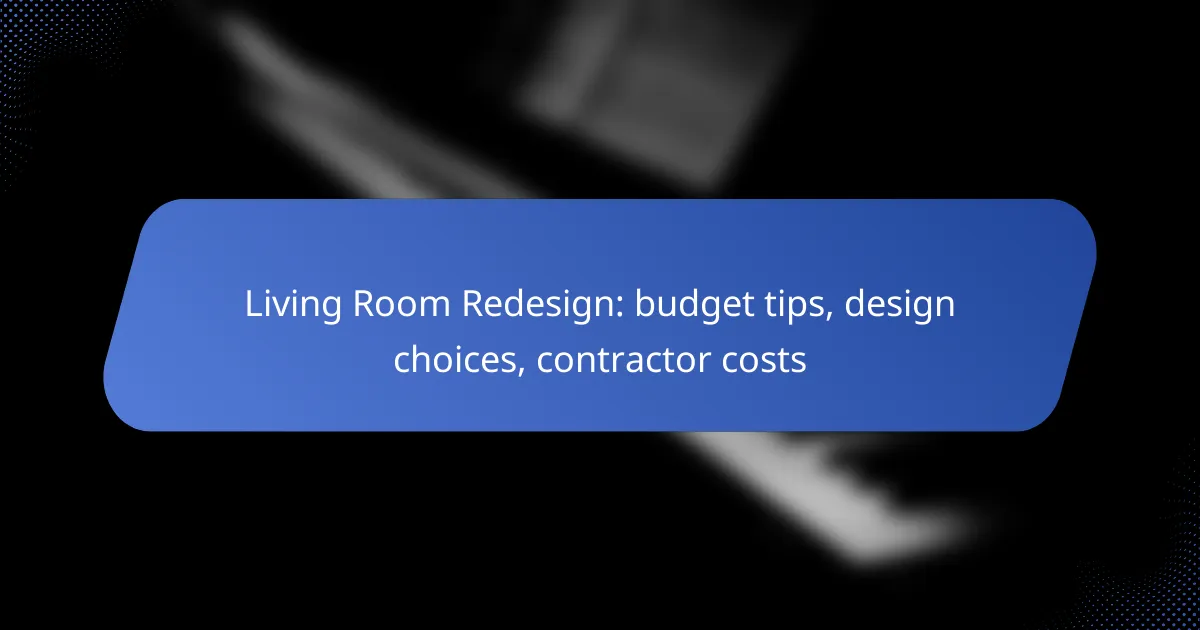Remodeling your kitchen can be a significant investment, with average costs in the UK ranging from £5,000 to £25,000 based on project scope and material choices. It’s essential to balance your budget with desired upgrades while considering the potential return on investment, which typically falls between 60% and 80%. The materials you select will greatly impact both the overall cost and the aesthetic appeal of your new kitchen.

What are the average kitchen remodel costs in the UK?
The average kitchen remodel costs in the UK typically range from £5,000 to £25,000, depending on the scope of the project and the materials used. Homeowners should consider their budget, desired upgrades, and potential return on investment when planning their remodel.
Average cost range for a kitchen remodel
The cost of a kitchen remodel can vary significantly based on factors such as size, materials, and labor. Basic remodels may start at around £5,000, while high-end renovations can exceed £25,000. Most mid-range projects generally fall between £10,000 and £15,000.
Investing in quality materials and appliances can enhance both the functionality and aesthetics of the kitchen, but it’s essential to balance quality with budget constraints. Homeowners should aim for a remodel that meets their needs without overspending.
Factors influencing kitchen remodel costs
Labor costs can also vary based on the region and the expertise of the contractors. It’s advisable to obtain multiple quotes and consider the reputation of the contractors to ensure quality work without excessive expenses.
Cost breakdown by kitchen size
The size of the kitchen plays a crucial role in determining the remodel costs. For small kitchens, costs may range from £5,000 to £10,000, focusing on essential upgrades. Medium-sized kitchens typically cost between £10,000 and £20,000, allowing for more extensive renovations and better materials.
Large kitchens often require a budget of £20,000 or more, especially if structural changes or high-end finishes are involved. Homeowners should carefully assess their needs and prioritize features that will provide the most value and satisfaction in their space.

What is the potential ROI of a kitchen remodel?
The potential return on investment (ROI) of a kitchen remodel can vary significantly based on factors such as the scope of the project, materials used, and local real estate market conditions. Generally, homeowners can expect a ROI ranging from 60% to 80% when selling their home after a kitchen renovation.
Average ROI percentages for kitchen remodels
The average ROI for kitchen remodels typically falls between 60% and 80%, depending on the extent of the renovation. Minor remodels, such as updating fixtures and finishes, often yield higher percentages compared to major overhauls that involve structural changes. For instance, a minor kitchen remodel may return around 80% of the investment, while a full-scale remodel might return closer to 60%.
Factors affecting ROI in kitchen renovations
Another important factor is the overall design and functionality of the kitchen. A well-designed space that enhances usability can attract potential buyers, increasing the likelihood of a favorable return. Lastly, the timing of the remodel in relation to market trends can also affect the ROI.
Comparative ROI of different remodel types
Different types of kitchen remodels can yield varying ROI percentages. For example, a minor kitchen remodel, which includes updates like new countertops and appliances, often provides a higher ROI than a major remodel that involves layout changes or expansions. Homeowners should consider focusing on cosmetic updates for better returns.
In addition, specific features can enhance ROI. For instance, energy-efficient appliances and modern cabinetry are appealing to buyers and can increase the value of the home. On the other hand, overly personalized or extravagant designs may not appeal to the broader market, potentially lowering ROI.

What material choices impact kitchen remodel costs?
The materials selected for a kitchen remodel significantly influence overall costs. Factors such as quality, durability, and aesthetics play a crucial role in determining the price of countertops, cabinets, and flooring.
Popular countertop materials and costs
Countertop materials vary widely in price and quality. Common choices include laminate, which can cost around $20 to $50 per square foot, and granite, which typically ranges from $40 to $100 per square foot. For a high-end option, quartz can run from $50 to $150 per square foot.
When selecting a countertop, consider durability and maintenance. For instance, while granite is durable, it requires sealing to prevent stains, whereas quartz is non-porous and easier to maintain. Weigh these factors against your budget and lifestyle needs.
Cabinet material options and pricing
Cabinet materials greatly affect both appearance and cost. Stock cabinets made from particleboard or MDF can start at around $100 to $300 per linear foot, while solid wood cabinets typically range from $200 to $600 per linear foot. Custom cabinetry can exceed $1,000 per linear foot depending on the design and materials used.
Choosing the right cabinet material involves balancing cost with quality. Solid wood offers longevity and a classic look, while laminate is budget-friendly but may not last as long. Consider your kitchen’s style and how often you use it when making your decision.
Flooring material choices and their costs
Flooring options for kitchens include tile, hardwood, laminate, and vinyl, each with varying costs. Ceramic tile can range from $1 to $15 per square foot, while hardwood typically costs between $5 and $15 per square foot. Luxury vinyl planks are a popular choice, averaging $2 to $7 per square foot.
When selecting flooring, consider factors such as durability, water resistance, and ease of cleaning. Tile is highly durable and water-resistant, making it ideal for kitchens, while hardwood offers warmth but may require more maintenance. Evaluate your lifestyle and budget to find the best fit for your kitchen remodel.

How to choose the right kitchen layout?
Choosing the right kitchen layout involves understanding your cooking habits, available space, and how you want to interact with the kitchen. A well-planned layout enhances functionality and can improve the overall flow of your home.
Common kitchen layouts and their benefits
There are several common kitchen layouts, each offering unique advantages. The most popular include the U-shape, L-shape, galley, and island layouts. For instance, the U-shape provides ample counter space and storage, making it ideal for larger kitchens.
The L-shape layout is versatile and works well in open-concept homes, allowing for easy movement and interaction with adjacent living areas. Galley kitchens are efficient for smaller spaces, maximizing functionality with a streamlined design.
Island kitchens add extra workspace and can serve as a social hub, perfect for families or entertaining guests. Each layout can be tailored to fit your specific needs and preferences.
Factors to consider for kitchen layout selection
When selecting a kitchen layout, consider the size and shape of your kitchen, as well as your cooking style. For example, if you frequently host gatherings, an island layout might be beneficial for socializing while cooking.
Think about the work triangle concept, which emphasizes the relationship between the sink, stove, and refrigerator. This triangle should be efficient, ideally allowing for easy movement between these key areas.
Additionally, assess your storage needs and how much counter space you require. Avoid overcrowding the kitchen with too many cabinets or appliances, which can hinder functionality. Prioritize a layout that promotes ease of use and comfort in your cooking environment.

What are the latest trends in kitchen remodeling?
The latest trends in kitchen remodeling focus on creating functional, stylish spaces that enhance both aesthetics and usability. Homeowners are increasingly prioritizing open layouts, eco-friendly materials, and smart technology integration to improve their cooking and entertaining experiences.
Emerging design trends in UK kitchens
In the UK, open-plan kitchens continue to gain traction, allowing for seamless transitions between cooking and living areas. This design promotes social interaction and maximizes space, making it ideal for family gatherings and entertaining guests.
Another notable trend is the use of bold colors and unique textures. Homeowners are moving away from traditional whites and neutrals, opting instead for deep blues, greens, and even patterned tiles to create striking focal points.
Innovative materials gaining popularity
Eco-friendly materials are becoming increasingly popular in kitchen remodels. Options like bamboo, recycled glass, and reclaimed wood not only reduce environmental impact but also add character to the space.
Additionally, engineered stone surfaces are gaining favor due to their durability and low maintenance. These materials offer a wide range of colors and patterns, making them suitable for various design styles while providing resistance to scratches and stains.

What are the steps to plan a kitchen remodel?
Planning a kitchen remodel involves several key steps to ensure a successful outcome. Start by defining your goals, setting a budget, and considering the layout and materials that best suit your needs.
Initial planning and budgeting steps
Begin your kitchen remodel by establishing a clear budget. Typical kitchen remodel costs can range from a few thousand to tens of thousands of dollars, depending on the scope of work and materials chosen. Prioritize your needs and wants to allocate funds effectively.
Next, create a detailed plan that includes the layout, design elements, and materials. Research current trends and gather inspiration from magazines or online platforms. This will help you visualize the final result and guide your decisions.
Hiring contractors vs. DIY approaches
Deciding between hiring contractors and taking a DIY approach depends on your skill level and the complexity of the remodel. Hiring professionals can ensure high-quality work and adherence to local building codes, but it typically comes at a higher cost.
If you opt for DIY, assess your abilities realistically. Simple tasks like painting or installing hardware can be manageable, while plumbing or electrical work may require professional help. Always consider the potential for mistakes that could lead to additional expenses.

How to maximize space in a small kitchen remodel?
To maximize space in a small kitchen remodel, focus on efficient layouts and multifunctional furniture. Incorporating smart storage solutions and open shelving can significantly enhance usability and create an illusion of more space.
Utilize vertical space
Using vertical space is essential in a small kitchen. Install cabinets that reach the ceiling to take advantage of every inch, and consider adding shelves above countertops for additional storage. This approach not only frees up floor space but also keeps frequently used items within easy reach.
Another effective strategy is to hang pots and pans or use magnetic strips for knives and utensils. This not only saves drawer space but also adds a decorative element to your kitchen.
Choose compact appliances
Opting for compact appliances can greatly enhance functionality in a small kitchen. Look for models that are designed for smaller spaces, such as slim refrigerators or combination microwave-ovens. These appliances often have the same features as their larger counterparts but take up significantly less room.
Additionally, consider built-in appliances that blend seamlessly with cabinetry. This can create a streamlined look while maximizing available space.
Incorporate multifunctional furniture
Multifunctional furniture is a game changer in small kitchens. A kitchen island with built-in storage can serve as both a prep area and a dining space. Folding tables or drop-leaf counters can provide extra surface area when needed and be tucked away when not in use.
Bar stools that can be stored under the counter when not in use can also help maintain an open feel. Look for furniture that can adapt to your needs without sacrificing style.










